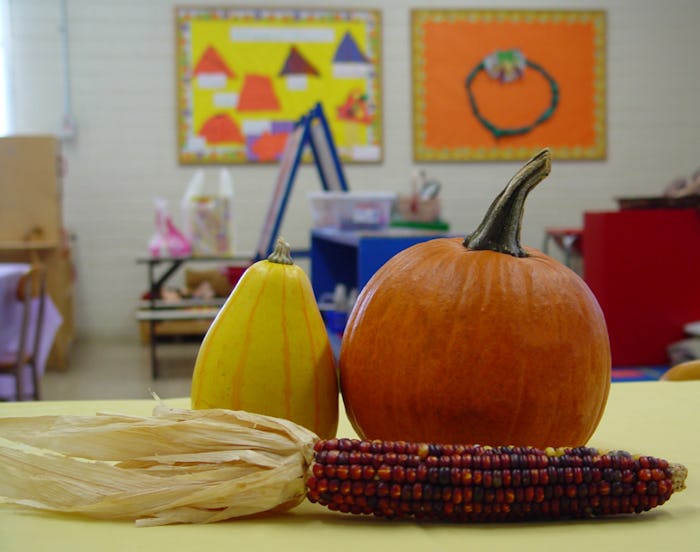Life

5 Things Preschool Teachers Want Parents To Know About Thanksgiving At School
Right now, parents and preschool teachers are both counting down the days until Thanksgiving, but for totally different reasons. You're planning family weekend activities and worrying whether you bought a big enough turkey; teachers are looking forward to four days without children sneezing in their faces or moaning, "She touched my haaaaiiirr!" But since the holiday provides lots of teachable moments, there are things preschool teachers want parents to know about Thanksgiving preparations at school.
The preschool year is all about taking a closer look at the people, places, things, and concepts that a 4-year-old encounters in their everyday life, be it water, light, winter, clothing, community helpers, or cultural celebrations. Teachers plan lessons and activities around these themes to deepen students' understanding, while at the same time strengthening kindergarten-readiness skills. A pre-K class might spend a morning cutting out pictures of Thanksgiving foods to improve their scissors grip, or play a turkey-feather counting game in which they have to pick a card with a number, read the numeral, and count out that number of paper feathers to put on a turkey template.
If you're the parent of a preschooler who always says, "Nothing" when you ask, "What did you do at school today?", you may be relieved to know that lots of things do go on. And in late November, here's what you're likely to see in a pre-K classroom as it prepares for Thanksgiving.
It May Or May Not Involve Pilgrims
Different preschools have different ways of teaching their students about Thanksgiving. It used to be that everyone across the board got the basic Pilgrims-Mayflower-Squanto-harvest-celebration story, and then kids made paper headdresses and buckle hats. But in these enlightened times, it's hard to paint an everything is awesome! picture, knowing that the European colonists went on to drive the indigenous tribes off their own lands. The challenge for teachers now is to teach Thanksgiving in a culturally sensitive way, as the National Association for the Education of Young Children points out. Some teachers may discuss the Wampanoag tribe in addition to the Pilgrims; others may delve into a full look at honoring cultural differences of all sorts. And still others may opt to keep it simple and focus on the basic holiday traditions instead.
Thankfulness Is Emphasized
Although preschoolers may not fully grasp the whole history lesson, they're old enough to understand the concept of gratitude. Mine is one of the many preschool classrooms that spends a large chunk of Thanksgiving week discussing what it means to be thankful, and what each child is personally thankful for. Your child's class may create a thankfulness craft or project to honor the occasion. One year, my school distributed paper "feathers" to all the families, on which they wrote things they were grateful for. We gathered all the feathers and attached them to a large paper turkey. It brought home the message in a meaningful way.
There May Be A Classroom Feast
What would a preschool Thanksgiving lesson plan be without a nod to the traditional foods? Your preschool may have students create a dish to eat in class (a great opportunity to teach measuring and the science of cooking), or invite families to bring in foods that reflect their home culture. Preschool teacher Karen Cox, writer of the PreKinders blog, suggested that students make roll-up sandwiches using deli turkey slices on flatbread — which may be more appetizing to 4-year-olds than a roast turkey. I like to have my class create "pumpkin pie in a cup": crushed graham crackers, vanilla pudding with a little canned pumpkin and cinnamon mixed in, and whipped cream on top. Yum!
Lessons Will Be Holiday-Themed
Everyone may be excited about the upcoming holiday (not to mention that long weekend), but that doesn't mean the learning has to stop. This is the time when preschool teachers get creative with their lessons. Sensory play might involve kneading and rolling pie dough, or tracing letters on a tray lined with pumpkin pudding. The dramatic play center makes a natural setting for kids to act out the cooking and preparation for a family dinner. My math center at Thanksgiving includes a "roll-a-turkey" game: Students take turn rolling a die, then drawing a portion of a turkey corresponding to a key (1 for a head, 3 for feet, etc.) They may end up with a bird that has one feather and three heads, but that's all part of the fun.
Art Projects Are Mandatory
Much about education has changed over the decades, but there's one thing you can pretty much be sure of: Sometime in late November, your preschooler will be bringing home a Thanksgiving-themed craft. The time-honored turkey handprint is still a hit in classrooms, but depending on the teacher's preference, your child might make napkin rings, pine-cone turkeys, or another decoration. Education.com suggested that preschool classrooms make crafts related to the harvest season, such as this textured ear of corn. Whatever it is, you'll be sure to cherish it and display it on your holiday table for years to come.
By the end of the day (which, in this case, means the Wednesday before Thanksgiving, and which may be an abbreviated day for the benefit of early travelers), preschoolers should come away from a Thanksgiving unit of study with a sense of the significance of the holiday. However, we teachers can't guarantee our lessons will make your children willing to try roasted brussels sprouts at your family dinner.